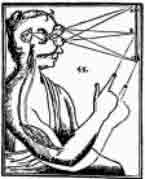What Does Descartes Mean By Animal Spirits
Rene Descartes
1596-1650
 Rene Descartes, a French mathematician, philosopher, and physiologist was a pivotal figure in philosophical thinking in the 17th century, and, indeed yet is today. His ideas atomic number 82 him to a conceptual separation of the mind (what he referred to every bit "soul") and the body. This separation between what today might be called psychological and physical phenomena, has come to be known as "Cartesian dualism". Descartes saw the mind every bit having a split status from the world of quantifiable material things such as the physical things that keep in the trunk. He explained the torso likewise as other material phenomena with reference to shapes, sizes and motions of elements of matter.
Rene Descartes, a French mathematician, philosopher, and physiologist was a pivotal figure in philosophical thinking in the 17th century, and, indeed yet is today. His ideas atomic number 82 him to a conceptual separation of the mind (what he referred to every bit "soul") and the body. This separation between what today might be called psychological and physical phenomena, has come to be known as "Cartesian dualism". Descartes saw the mind every bit having a split status from the world of quantifiable material things such as the physical things that keep in the trunk. He explained the torso likewise as other material phenomena with reference to shapes, sizes and motions of elements of matter.
Descartes conceptual model of heed and body acknowledges that the listen and body intermingle. Sensations like burning oneself for instance, are intertwined with mental reactions of hurting.
Descartes hypothesized that animal spirits or pneuma served as the basis of nerve and muscle function. He theorized further that the finest particles in the claret passed through the pineal gland on their mode to the brain, where they turned into animate being spirits. The spirits, something like the current of air, traveled to the pores in the lining of the ventricles of the brain. The nerves were seen every bit tubes whose function information technology was to acquit the animal spirits from ane part of the body to another. Stimulation of a sense organ activated the filaments in the nerve tubes, which conveyed the sense data to the ventricles. From there they traveled automatically, like a reflex, through the fretfulness to the muscles.
Likewise operating in Descartes' mechanistic renderings was a rational soul that worked independently of the muscle action. The interaction between the soul and torso took place, according to Descartes, in the pineal gland, and it was there that the person (but not other animals) were able to have a witting appreciation of the sensation and it was there that voluntary movements of the muscles were initiated. The pineal gland acted every bit a floating valve to the third ventricle and took role in the processing of sensation, imagination, memory and the causation of voluntary bodily movements.
In this work, Descartes proposed a mechanism for automatic reaction in response to external events. According to his proposal, external motions affect the peripheral ends of the nerve fibrils, which in plow readapt the central ends. Equally the central ends are displaced, the design of interfibrillar infinite is rearranged and the menses of brute spirits is thereby directed into the advisable fretfulness. It was Descartes' articulation of this mechanism for automatic, differentiated reaction that led to his beingness credited with the founding of reflex theory.
Although Rene Descartes drew from the tradition of scholastics such as Thomas Aquinas, he created a shift in direction from scholastic research that was to take long-lasting bear upon. He agreed with Aristotle and his followers that the intellect or soul can operate independently of the body and that it is immortal. Just, unlike Aristotle, Descartes saw the soul as more active, serving to create consciousness. Other functions that Aristotle saw as part of the soul, Descartes relegated to the torso. These included nutritive functions (diet, growth, reproduction) and sense functions (perception, locomotion). Descartes conceived of these bodily functions in mechanistic terms.

Light from the object (ABC) enters the optics and form visual images on the retina. The images are connect to the walls of the ventricle past hollow tubes representing the optic nerve. From the tubes the image is taken by animal spirits to the ventricles and from there to the pineal gland (marked H on the drawing). Hither the motor response is initiated and carried through the opening eight into the nerve to the arm muscle, which it inflates, producing movement.
A sampling of the writings of Rene Descartes
Descartes, Rene (1633). The treatise on man
Descartes, Rene (1637). Discourse on method
Descartes, Rene (1641). Meditations on outset philosophy
Descartes, Rene (1649). The passions of the soul
Writings about Rene Descartes's theories of the heed and trunk.
Bennett, G. R. & Hacker, P. M. S. (2002). The motor system in neuroscience: A history and analysis of conceptual developments. Progress in Neurobiology, 67, 1-52.
Source: https://www.acsu.buffalo.edu/~duchan/new_history/early_modern/descartes.html#:~:text=Descartes%20hypothesized%20that%20animal%20spirits,they%20turned%20into%20animal%20spirits.
Posted by: waitbrobbegreare1964.blogspot.com

0 Response to "What Does Descartes Mean By Animal Spirits"
Post a Comment